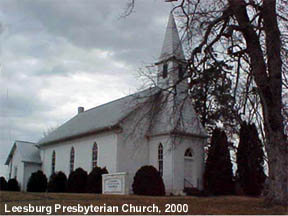Location
About 500 yards from the Old Stage Road near TN Hwy 81 at Fairview. It stands among old trees on a hill, overlooking the graves of many early members of the church, some of which are unmarked graves of slaves.
History
The church was organized in 1818 by the Rev. John Whitfield Doak, a son of the Rev. Samuel Doak.
The present church was built in 1883 of brick masonry with additions of brick veneer which were erected since 1930. An interesting architectural feature is the shape of the roof of the narthex, the entrance area which supports the steeple. The church has a chandelier given by the Rev. E.O. Guerrant, M.D., founder of many churches in Eastern Kentucky.
There is a tradition that the present building is the third one that the church has occupied, the two earlier buildings having burned. The first was made of logs and the second of brick. In 1835 subscriptions were being taken for a church building, probably the second one. Prior to 1842, the records show that the Session met at various places – homes of Ruling Elders, Duncan’s Schoolhouse, the Male Academy in Jonesboro, and the Salem church at Washington College.
On 7 February 1834, John Strain was replaced as the first Clerk of the Session by John Stephenson. who began the first book of minutes by writing a narrative history of the church. The first minutes which are dated have the date of 11 May 1835. There are four books of minutes of the Session: the first dating from 1818- 23 June 1867; the second from 1867 – 4 April 1896; the third from 1896 – 28 April 1947 and the fourth from 1947 – present.
The Session compiled a list of members in 1836, at which time the church had 115 members. The list was updated in 1842.
In the early days church funds were obtained by subscription. In 1860 the Presbytery requested the churches to adopt a system for giving to benevolences; the Session resonded by placing boxes in the church, each labeled for a different fund, e.g. Foreign Missions, Education, Home Missions. This system was still in use at least until 1870.
Life and the Church
During the first 75 years of the Church’s existence, the Elders took seriously their responsiblility for encouraging attendance at worship services. From time to time the Session sent committees to call on members who had “absented themselves from church” to inquire about the reason for absence and to remind them of their duty to attend.
During these years the Session also assumed responsibility for deciding when a member had acted or spoken inconsistently with the moral standards of the day, of the church, or of a particular pastor or Session. One of the earliest examples on record is that of a member accusing of “telling lies and causing mischief among neighbors.” Sessions reacted to “common fame” or gossip by sitting as a court to decide on the innocence or guilt of the person accused of misconduct. Accused members were requested to appear before the Sessons to answer allegations of intemperance, intoxication, drunkeness, adultery, fornication, profanity, taking too much toll as a miller, threatening to take life, having a ball in their home, dancing, fighting, and betting on elections. In some cases the member was found not guilty, but in other cases the member was suspended until he or she gave “evidence of repentance.”
In 1835 a member applied for dismission to join a “Methodist Church at McCrackins”, then a new demonination in the area. He was requested to appear before the Session, apparently to explain why he wanted to become a Methodist. The record does not show whether he ever satisfied the Sessions’s curiosity.
In 1852 the Session adopted four resolutions which reflect its sense of authority and its stand on alcoholic beverages, dancing, attending public worship, and admitting members of other churches to the Lord’s Table. The first resolution condemned persons who “engage in the manufacture of intoxicating drinks or in the vending of such drinks, or who use them as a habitual beverage.” The second resolution condemned persons who are in the “habit of dancing or encouraging dancing parties or balls in their homes.” The third stated that “it is incumbent duty of members of Christ’s church to attend upon the ordinances of his house” and that “in failing to so so most faithfully and punctually, unless providentially hindered, they are neglecting a high an dsolemn duty and setting a bad example before the church and the world and acting inconsistently with their profession.” The fourth resolution stated that the Session “most cordially and affectionately invites to the Lord’s Table all who are regular and consistent members of all sister Protestant churches and welcome them to come and obey with us the commandment of our Saviour, ‘This do in remembrance of Me.'”
Members
First Ruling Elders elected: John Strain, James Cowan and John Cowan. John Strain was also the first Justice of the Peace appointed in Tennessee, receiving his appointment from John Sevier.
Pastors
The Rev. John W. Doak was installed as pastor in the Fall of 1819.
Throughout most of its history, Leesburg Presbyterian church has had part-time pastors and for periods of various lengths has had no pastor. When an ordained minister could not be obtained, lay preachers conducted worship services.
Cemetery
See the Leesburg Presbyterian Church Cemetery.
Source: Leesburg Presbyterian Church, 1818-1982, Washington County, Tennessee, compiled by Mary Sue Carson Goins. 1981. Contributed by Elaine Cantrell. Posted 13 Nov 2004.

